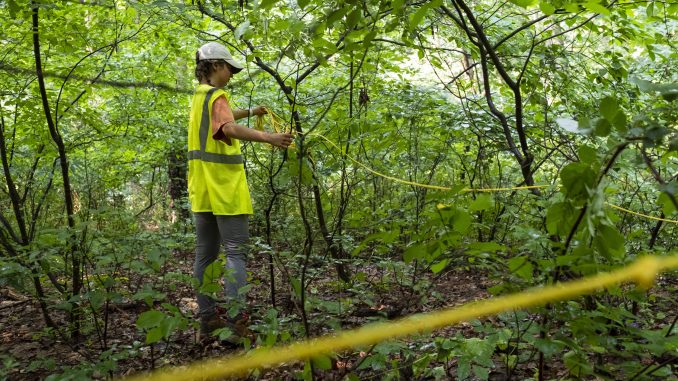
Curious about the interaction between trees and the environment, Chloe Gehret spent the majority of her summer in the Temple Ambler Field Station researching the red oak species.
“It’s been a great experience to be able to go out and actually conduct research in the forest that’s run by Temple University, it’s kind of like a separate side of Temple but in nature,” said Gehret, a junior ecology, evolution and biodiversity major.
During the summer, Gehret researched why the red oak species grew in specific areas in the field station. This fall, she will expand her research to see how red oak growth is affected by animals feeding on them.
From her findings in the summer, Gehret concluded all the adult and sapling red oaks growing in the field station are in a cluster distribution, growing in proximity in specific areas and not equally spaced out. She noticed saplings were in close vicinity of adult red oaks and grew in areas where there weren’t many other plant species.
This inspired her research plans for the fall to examine how animals, like deer, squirrels and insects, feeding on these saplings affect their growth, she said.
Gehret will check weekly on differently sized cages that will be set up with seeds in them and also on seeds planted in the open to see which seeds are being fed on, she said.
Gehret joined professor Amy Freestone, director of the field station and Temple’s ecology, evolution and biodiversity program lab her freshman year of college. Gehret conducted computer research and worked with biology graduate students Mariana Bonfim and Mary Cortese.
Cortese has enjoyed watching Gehret grow as a researcher and individual, she said.
“She’s always one to do a little bit more and push her research a little bit further, which is really exciting to watch,” Cortese said.
After COVID-19 restrictions eased, Freestone offered Gehret a position at the Temple Ambler Field Station in the spring of 2020. The field station enables students to conduct fieldwork on the 187 acres of old growth and secondary forests, meadows, streams and gardens on the Ambler campus, which opened in Fall 2020.
“It was my pleasure to invite her to have her join the lab, and then her role in the lab has shifted through time as we’ve had different opportunities to offer to her, but she has been just a fantastic team member now for quite a while,” Freestone said.
Once Gehret started working at the field station, she assisted with the forest census, where she mapped and measured woody plants in the field station.
During her time in the spring, Freestone helped Gehret focus her research on red oaks, because they are abundant and Gehret wanted to understand why trees were able to survive in certain locations, she said.
Through her curiosity and the help from Freestone and the graduate students, Gehret was able to develop an idea for an independent research project on the red oaks species, she said.
Gehret applied to the Diamond Research Scholar Program, a program that allows Temple students to conduct mentored research or creative projects.
Gehret chose Freestone as her mentor, because she has provided her with many opportunities and supported her throughout college, Gehret said.
“I met with her and her kind words and comforting nature immediately drew me in,” Gehret said.
Gehret’s goal is to present at a larger conference and publish her findings, she said.
“After college, I’m considering graduate school, and I know that having a publication is definitely the first step to getting into a prestigious grad school and just continuing my career as an ecologist,” Gehret said.



Be the first to comment